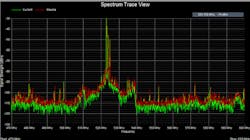Electronic warfare (EW) project seeks signals intelligence (SIGINT) solutions for RF and microwave threats
CRANE, Ind. – U.S. Navy electronic warfare (EW) experts are reaching out to industry for new ways of detecting and countering enemy RF and microwave threats by automatically alerting warfighters to abnormal signals.
Officials of the Naval Surface Warfare Center Crane Division in Crane, Ind., issued a request for solutions on Monday (N0016420SNB55) for the Radio Frequency Spectrum Dominance (RFSD) Prototype Project.
This two-to-three-year project aims at providing warfighters with an enhanced understanding of their battlefield environment by collecting and analyzing RF signals to compare against a baseline environment.
Military signals intelligence (SIGINT) personnel supporting deployed missions today have little to no control of the frequency spectrum, which results in a lack of awareness into using radio, cell phones, wireless networks, the internet, 5G, and mesh communications, researchers explain.
This shortcoming is made worse by enemy wireless devices like unmanned aerial vehicles (UAV) and IP-based communications within about three miles from fixed bases and underway maritime vessels.
Enemy propaganda on the internet and cyber warfare attacks on military supply chains makes it more important than ever to recognize trusted devices and components and control of the acquisition supply chain.
Intercepting and interpreting RF and microwave signals today is an underdeveloped capability, Navy researchers point out. Improved RF spectrum analysis will enable warfighters greater ability to counter RF threats -- especially the enemy's use of remote UAVs and improvised explosive devices (IEDs).
It is difficult -- if not impossible -- for humans to discern dangerous from innocuous frequencies with standard tools. Technologies exist today that parse through radio frequencies, yet there is a need to advance these systems.
The U.S. Department of Defense (DOD) seeks a capability to detect and counter emerging threats that use internet, telecommunications, and the electromagnetic spectrum.
From industry, Navy researchers want a prototype that will collect RF signals between 40 MHz and 6 GHz, analyze the signals, compare against a baseline, and automatically alert warfighters to anomalous signals.
Proposed prototypes For a prototype to be considered successful, the performer will conduct a Final Demonstration of the prototype on DOD range facilities.
Companies interested must be members of the Strategic & Spectrum Missions Advanced Resilient Trusted Systems (S2MARTS) consortium. More information on the S2MARTS consortium is online at https://s2marts.org. Information about joining is at https://nstxl.org/register-now.
Companies interested should respond no later than 15 June 2020 online at https://nstxl.org/opportunity/rf-spectrum-dominance/. Click the submit a solution tab to send proposals.
For questions or concerns contact the Navy's Jason Clark by email at [email protected], or by phone at 812-854-3320. Also contact Don Davis by email at [email protected], or by phone at 812-854-3709.
More information is online at https://beta.sam.gov/opp/e86ee4715097403eb877fbe6d2cf5695/view.
About the Author
John Keller
Editor-in-Chief
John Keller is the Editor-in-Chief, Military & Aerospace Electronics Magazine--provides extensive coverage and analysis of enabling electronics and optoelectronic technologies in military, space and commercial aviation applications. John has been a member of the Military & Aerospace Electronics staff since 1989 and chief editor since 1995.
